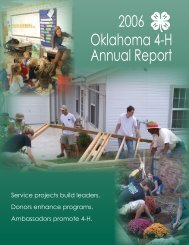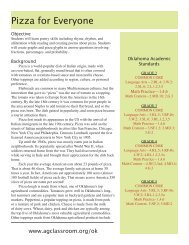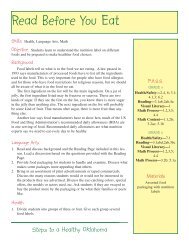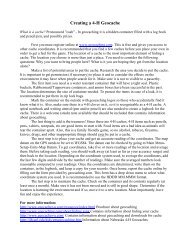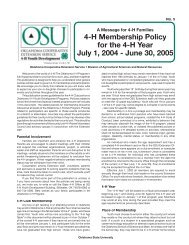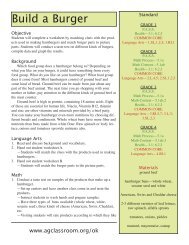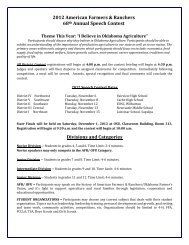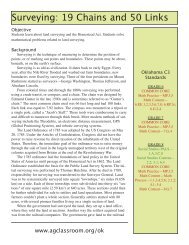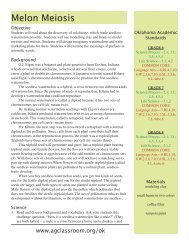You also want an ePaper? Increase the reach of your titles
YUMPU automatically turns print PDFs into web optimized ePapers that Google loves.
<strong>Say</strong> <strong>Cheese</strong>!<br />
Objective<br />
Students make soft cheese from milk and rennet or from milk and<br />
lemon juice.<br />
Background<br />
<strong>Cheese</strong> has been a popular food for centuries. According to<br />
legend it was discovered several thousand years ago by an Arabian<br />
traveler who placed milk into a pouch made of a sheep’s stomach.<br />
During the day’s journey, the combined action of the sun’s heat and<br />
the enzymes in the lining of the stomach changed the milk into a<br />
snowy white curd of cheese and the thin liquid called whey.<br />
Today some cheeses are made by taking rennin from the stomach<br />
of a calf and adding it to milk. Rennin is a natural complex of<br />
enzyme found in mammalian stomachs that is used to digest mother’s<br />
milk. When added to milk, it causes a semisolid mass (curd) to form<br />
and separate from the liquid (whey). The whey left over from the<br />
cheese-making process is used in animal feed or to make ice cream.<br />
When you make cottage cheese, you are making a culture. The<br />
warm milk provides the warm and wet environment the bacteria need<br />
to grow.<br />
Different strains of microbes are used to produce different kinds<br />
of cheese. Factories produce cheese in 500-pound blocks. When it is<br />
first made, cheese has little flavor. It takes three months to make mild<br />
cheese and at least a year to make sharp cheese. Manufacturers keep<br />
the cheese in the refrigerator until it is ready. Then they cut off the<br />
mold that grows on the surface. All cheese is naturally white. Yellow<br />
cheeses are yellow because color is added to them.<br />
Science Activity<br />
1. Write the following on the chalk board: “Little Miss Muffet sat on<br />
a tuffet, eating her curds and whey.” Students will explain what<br />
Miss Muffet was eating in the nursery rhyme.<br />
2. Read and discuss background and vocabulary.<br />
3. Use one or both of the recipes included with this lesson to demonstrate<br />
cheesemaking for students. Older students may work in<br />
groups to make the cheese themselves.<br />
4. While students wait for the results of the cheesemaking activity,<br />
hand out vocabulary worksheets. Students will work in groups to<br />
find definitions for the vocabulary words.<br />
5. Students will use the worksheet to record their observations as<br />
they conduct the experiment or watch the demonstration.<br />
<strong>Oklahoma</strong> Academic<br />
Standards<br />
KINDERGARTEN<br />
Science Process—1.2,3<br />
Physical Science—1.1<br />
GRADE 1<br />
Science Process—1.2; 2.1;<br />
3.1,2,3,4; 4.3<br />
Physical Science—1.1<br />
GRADE 2<br />
Science Process—1.1,2;<br />
2.1; 3.1,2,3,4; 4.3<br />
GRADE 3<br />
Science Process—1.1,2;<br />
2.1; 3.1,2,3,4; 4.3<br />
GRADE 4<br />
Science Process—1.1,2;<br />
2.1; 3.1,2,3,4; 4.3,4<br />
GRADE 5<br />
Science Process—1.1,2;<br />
2.1; 3.1,2,3,4; 4.3,4<br />
GRADE 6<br />
Science Process—1.1,2,3;<br />
2.1; 3.1,2,3,4,5,6; 4.1,3,4,5;<br />
5.1,3,4<br />
Physical Science—1.1<br />
www.agclassroom.org/ok
6. Students will describe the finished product. How is it similar to the dairy<br />
products with which they are familiar? Students will record their observations<br />
on the student worksheets.<br />
Vocabulary<br />
bacteria—tiny organisms<br />
coagulate—to cause a liquid to<br />
change into a soft, semisolid, or<br />
solid mass<br />
culture—A colony of bacteria<br />
or other living matter grown in<br />
a specially-prepared nutrient<br />
medium<br />
curd—The thick substance that<br />
forms when milk ferments<br />
enzyme—a protein produced by<br />
a living organism that speeds up<br />
a chemical process<br />
rennin—a liquid extracted from<br />
enzymes found in a calf’s stomach<br />
Extra Reading<br />
Alphin, Elaine Marie, and Elaine Verstraete, Germ Hunter: A Story About<br />
Louis Pasteur (Creative Minds Biography), Carolrhoda, 2003.<br />
Basel, Roberta, From Milk to <strong>Cheese</strong>, Capstone, 2005.<br />
Birmingham, Christian, The Fight Against Microbes: Pasteur’s Story (Science<br />
Stories), Matthew Price, 2006.<br />
Fandel, Jennifer, Louis Pasteur and Pasteurization, Capstone, 2007.<br />
Llewellyn, Claire, Milk: What’s for Lunch, Franklin Watts, 2003.<br />
Peterson, Cris, Clarabelle: Making Milk and So Much More, Boyds Mills,<br />
2007.<br />
Reilly, Kathleen, and Samuel Carbaugh, Food: 25 Amazing Projects: Investigate<br />
the History and Science of What We Eat (Build It Yourself<br />
Series), Nomad, 2010.<br />
Solheim, James, and Eric Brace, It’s Disgusting and We Ate It! True Food<br />
Facts from Around the World and Throughout History, Aladdin, 2001.<br />
Taus-Bolstad, Stacy, From Grass to Milk, Lerner, 2004.<br />
Zemlicka, Shannon, From Milk to <strong>Cheese</strong>, Lerner, 2003.<br />
www.agclassroom.org/ok
<strong>Cheese</strong> Recipes<br />
With Rennet<br />
1 gallon homogenized milk, at room temperature<br />
saucepan<br />
room thermometer<br />
liquid thermometer<br />
1 rennet tablet (Available in most grocery<br />
stores. Ask your grocer.)<br />
1⁄4 cup lukewarm water<br />
large colander<br />
cheesecloth<br />
large bowl<br />
long knife<br />
1. Pour milk into a saucepan and allow it to reach room temperature<br />
2. Crush the rennet tablet, and dissolve it in the 1⁄4 cup water, then stir it into the milk.<br />
3. Check the mixture about every 30 minutes and record your observations on your worksheet. After 1-2 hours<br />
the mixture should begin to separate. (If you want to speed up the process, add 1/2 cup vinegar.)<br />
4. Pour off the whey, and cut the curd into 1⁄2 inch cubes with a long knife.<br />
5. Place the colander in the bowl, and line the colander with cheesecloth. Pour the mixture through. Drain thoroughly<br />
and squeeze out the moisture.<br />
With Lemon<br />
1gallon whole milk<br />
Juice of 4-6 Lemons, about 1/2 cup<br />
1 tsp. salt<br />
1. In a large pot over medium-low heat, gently bring the milk to 175 degrees Fahrenheit. Be sure to stir frequently<br />
to keep from scalding the milk.<br />
2. Turn off the heat. Add about 1/4 cup of lemon juice and stir well. Let sit for 15 minutes.<br />
3. After 15 minutes, the milk should be curdled, and the whey (the liquid) should be clear. If it’s still milky/<br />
cloudy, add more lemon juice, stir gently, and give it a few more minutes. Depending on the acidity of the<br />
lemon juice, it may take quite a bit more. It won’t hurt to use more, but if you use more than necessary, the<br />
final result will have a stronger lemon flavor.<br />
4. Line a colander butter muslin, and gently pour the curds into it. Allow it to drain for a few minutes, and then<br />
tie the corners of the muslin together to form a bag.<br />
5. Hang the curds to drain.<br />
6. Allow to drain for 1-2 hours, until it stops dripping and has firmed up a bit. (If you’re in a hurry you can<br />
speed the process somewhat by squeezing the bag gently from the top down).<br />
7. Remove the cheese and mix in the salt and fresh, chopped herbs, if desired. The cheese will keep in the<br />
refrigerator for 1-2 weeks.<br />
<strong>Oklahoma</strong> Ag in the Classroom is a program of the <strong>Oklahoma</strong> Cooperative Extension Service, the <strong>Oklahoma</strong><br />
Department of Agriculture, Food and Forestry and the <strong>Oklahoma</strong> State Department of Education.
Name____________________________________________________________<br />
<strong>Say</strong> <strong>Cheese</strong><br />
Find the definition of these words. Draw a line from the word to the correct definition.<br />
coagulate<br />
enzyme<br />
curd<br />
bacteria<br />
culture<br />
rennin<br />
whey<br />
a liquid extracted from enzymes found in a calf’s stomach<br />
a colony of Bacteria or other living matter grown in a specially-prepared nutrient<br />
medium<br />
to cause a liquid to change into a soft, semisolid or solid mass<br />
the thick substance that forms when milk ferments<br />
the watery substance that separates from milk as cheese is made<br />
a protein produced by a living organism that sppeds up a chemical process<br />
tiny organisms<br />
Write what you observe<br />
Room temperature________<br />
Temperature of the milk________<br />
Write three words that describe how the milk looked at the beginning of the experiment.<br />
1.____________________ 2.______________________ 3._______________________<br />
How long did it take for the milk to reach room temperature?________________<br />
Rennet is the solid form of rennin. Read your definition of rennin above and predict what will happen after you<br />
add rennin to the milk.<br />
Describe the appearance of the milk<br />
At the beginning<br />
After 30 minutes<br />
After two hours<br />
Write three words that describe how the milk looked at the end of the experiment.<br />
1.____________________________ 2.______________________ 3._______________________<br />
<strong>Oklahoma</strong> Ag in the Classroom is a program of the <strong>Oklahoma</strong> Cooperative Extension Service, the <strong>Oklahoma</strong><br />
Department of Agriculture, Food and Forestry and the <strong>Oklahoma</strong> State Department of Education.



